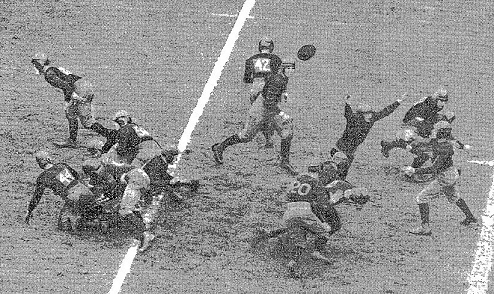
1927's story of the year was the suspension of Yale's star halfback, Bruce Caldwell. He had led them to a 5-1 start, including huge wins over Army (finished 9-1) and Dartmouth (7-1), but 4 days before Yale's game with 6-0 Princeton, a Providence newspaper reported that he had played in 2 games for Brown's freshman team in 1923, and according to Yale's eligibility rules, that meant that he was not eligible to play in 1927. After a brief investigation, Yale withdrew him from the team, despite protests from across the nation. Even Princeton and Harvard, Yale's last 2 opponents, requested that he be allowed to play out the season, but Yale was a stickler for rules. Despite the loss of Caldwell, Yale rallied in the 4th quarter to beat Princeton 14-6 (pictured above is Yale quarterback Johnny Hoben throwing a completed pass in that game), then they beat Harvard 14-0 to finish the season 7-1.
This is the last year for which Yale claims a mythical national championship, but the consensus retroactive choice for 1927 MNC is 7-0-1 Illinois, who took an early upset tie against 4-3-1 Iowa State.

 Yale
Yale 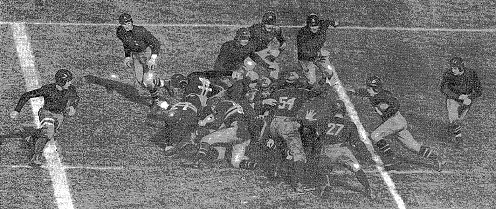
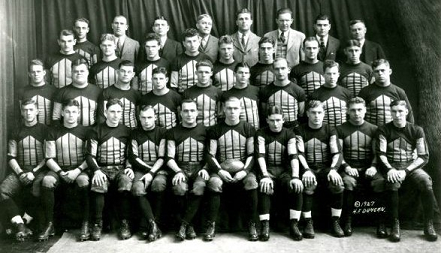
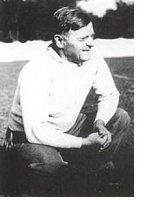 Illinois
should have called themselves the "Four Year Locusts" rather than the
Illini, as they were very close to following that schedule in winning
mythical national championships in 1914, 1919, and 1923,
and here they are claiming another one for 1927. I covered their Hall
of Fame coach, Robert Zuppke (pictured at left), in most detail in the
1914 article. Zuppke's success was nearing the end of the line, and
after going 7-1 and 6-1-1 the next 2 seasons, he would go just 41-52-2
over his final 12 years
Illinois
should have called themselves the "Four Year Locusts" rather than the
Illini, as they were very close to following that schedule in winning
mythical national championships in 1914, 1919, and 1923,
and here they are claiming another one for 1927. I covered their Hall
of Fame coach, Robert Zuppke (pictured at left), in most detail in the
1914 article. Zuppke's success was nearing the end of the line, and
after going 7-1 and 6-1-1 the next 2 seasons, he would go just 41-52-2
over his final 12 years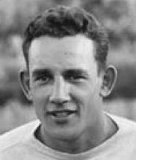 This team would come to be known as the "Dream and Wonder Team," a lame spin on California's "Wonder Teams" from the early part of the decade.
The head coach was George "Kid" Woodruff, who had been Georgia's
quarterback 1907-1908 and 1910-1911, and who coached at Georgia for 5
years 1923-1927 for a salary of just a dollar a year. Aside from this
one season of dreams and wonders, he was rather mediocre, going 21-15-1
in his other seasons, but he had an impressive trio of assistant
coaches who had all
played for Knute Rockne at Notre Dame
This team would come to be known as the "Dream and Wonder Team," a lame spin on California's "Wonder Teams" from the early part of the decade.
The head coach was George "Kid" Woodruff, who had been Georgia's
quarterback 1907-1908 and 1910-1911, and who coached at Georgia for 5
years 1923-1927 for a salary of just a dollar a year. Aside from this
one season of dreams and wonders, he was rather mediocre, going 21-15-1
in his other seasons, but he had an impressive trio of assistant
coaches who had all
played for Knute Rockne at Notre Dame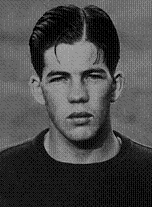 Texas A&M had gone 8-0 in 1917 and 10-0 in 1919
Texas A&M had gone 8-0 in 1917 and 10-0 in 1919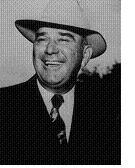 Centenary, a small school in Shreveport, Louisiana, went 10-0 in 1927,
which alone wouldn't put them in MNC contention-- Loyola-New Orleans
went 10-0 in 1926, and they would not even make a top 25 for that
season. But Centenary did not just beat up on minor teams-- they also
went 4-0 against SWC teams, and in a year when the SWC was unusually
strong (as per the above). Centenary also happened to have a Hall of
Fame coach at the helm-- Homer Norton (pictured at left), who went on
to greater fame at Texas A&M 1934-1947, winning 3 SWC titles and
A&M's only consensus national championship in 1939.
Centenary, a small school in Shreveport, Louisiana, went 10-0 in 1927,
which alone wouldn't put them in MNC contention-- Loyola-New Orleans
went 10-0 in 1926, and they would not even make a top 25 for that
season. But Centenary did not just beat up on minor teams-- they also
went 4-0 against SWC teams, and in a year when the SWC was unusually
strong (as per the above). Centenary also happened to have a Hall of
Fame coach at the helm-- Homer Norton (pictured at left), who went on
to greater fame at Texas A&M 1934-1947, winning 3 SWC titles and
A&M's only consensus national championship in 1939.